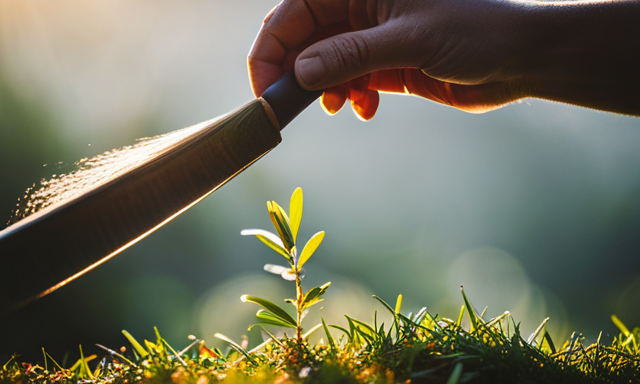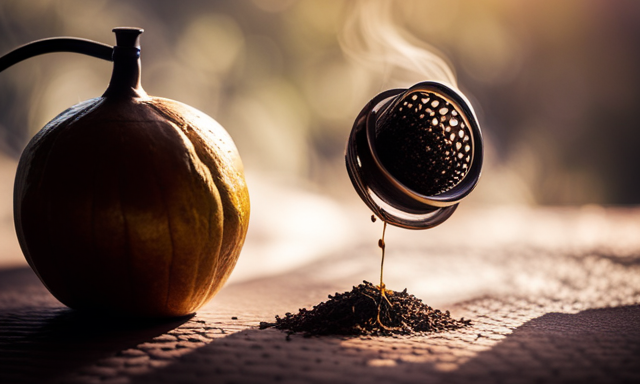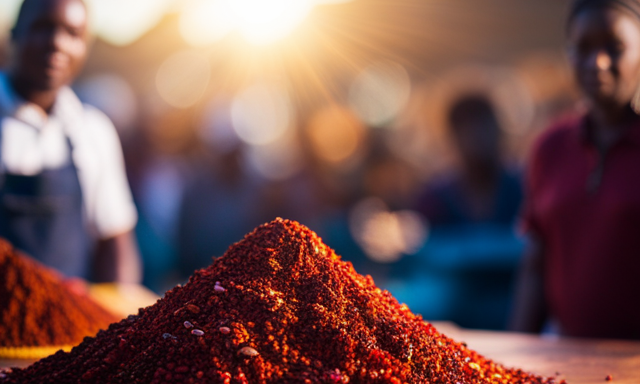Imagine a vast botanical treasure trove, where a single plant holds the secret to a delicious and healthful beverage. Welcome to the world of Rooibos tea, where the leaves of the remarkable Aspalathus linearis plant are harvested and transformed into a soothing and flavorful infusion.
As a tea enthusiast and researcher, I have delved into the depths of this remarkable plant to uncover the answer to a burning question: what part of the Rooibos plant is used for tea?
Through my exploration, I have discovered that the magic lies in the tender, needle-like leaves of the plant. These leaves are carefully plucked from the Rooibos shrub and undergo a meticulous drying and fermenting process to unlock their full potential.
Join me on this journey as we explore the fascinating world of Rooibos tea, from its origins on South African farms to its diverse flavors and its cherished place in local culture. So, let’s raise our cups and dive into the captivating story of Rooibos tea!
Key Takeaways
- Rooibos tea is made from the leaves of the Aspalathus linearis plant.
- The youngest and most flavorful leaves of the Rooibos plant are selected for harvesting.
- The leaves are spread out in the sun to dry naturally after harvesting.
- The dried leaves are lightly bruised and left to naturally ferment to enhance flavor and deepen the reddish hue of the tea.
Introduction to Rooibos Tea
The part of the rooibos plant that’s used for tea is the leaves, which have been carefully selected and processed to create a flavorful and soothing beverage.
Rooibos tea, also known as red bush tea, is a popular herbal infusion that originates from South Africa. It has gained international recognition for its numerous health benefits and delicious taste.
The history of rooibos cultivation can be traced back to the indigenous Khoisan people who first discovered the plant’s medicinal properties. Today, rooibos is grown in the Cederberg region of South Africa, where the unique climate and soil conditions contribute to its distinctive flavor profile.
The rooibos plant: a closer look reveals its vibrant green leaves, needle-like shape, and ability to thrive in harsh conditions.
With its rich history and unique characteristics, rooibos tea continues to captivate tea enthusiasts around the world.
The Rooibos Plant: A Closer Look
Take a sip of that delicious red elixir and you’ll be enjoying the essence of the Rooibos plant in no time. The Rooibos plant, also known as Aspalathus linearis, is native to the Cederberg region of South Africa. Cultivating this plant is not an easy task, as it requires specific conditions to thrive. Rooibos plants prefer sandy soil, warm temperatures, and ample sunlight. They are also known for their ability to withstand drought and poor soil conditions, making them a resilient crop. The properties of the Rooibos plant are what make it so special. It contains a wide array of antioxidants, such as aspalathin and nothofagin, which have been shown to have numerous health benefits. Additionally, Rooibos tea is naturally caffeine-free and low in tannins, making it a popular choice for those seeking a soothing and calming beverage. Harvesting the Rooibos leaves is the next crucial step in the process, where the leaves are carefully selected for optimal flavor and quality.
Harvesting the Rooibos Leaves
Get ready to experience the satisfaction of harvesting those vibrant leaves and unlock the full potential of this exquisite herbal elixir. Harvesting the Rooibos leaves requires careful techniques to ensure the highest quality yield.
The first step is to select mature plants, usually around 18 months old, that have reached their prime. Then, skilled farmers use sharp sickles to carefully cut off the topmost part of the plant, which contains the youngest and most flavorful leaves. These leaves are then collected in baskets and transported to the processing facility without delay to preserve their freshness.
At the facility, the leaves undergo a meticulous drying and fermenting process, which further enhances their unique flavor and aroma. This process, combined with the harvesting techniques, results in the exceptional taste and health benefits that make Rooibos tea so sought after.
Now, let’s delve into the fascinating drying and fermenting process.
Drying and Fermenting Process
Experience the transformative magic of the drying and fermenting process, as the vibrant leaves of this extraordinary herbal elixir are carefully nurtured into a rich and captivating infusion that will envelop your senses.
The drying process is a crucial step in the creation of rooibos tea. After the leaves are harvested, they are spread out in the sun to dry naturally. This allows the leaves to lose moisture and develop their distinct red color and woody aroma.
Once dried, the leaves undergo the fermentation process. This involves being lightly bruised to release enzymes and then left in heaps to naturally ferment for a specific period. This fermentation process enhances the tea’s flavor and deepens its reddish hue.
The result is a delicious and soothing beverage that is perfect for any time of day.
Transitioning into rooibos tea preparation methods, let’s explore the various ways to enjoy this exquisite elixir.
Rooibos Tea Preparation Methods
Discover the versatility of this remarkable herbal elixir – how can you resist exploring the myriad of ways to indulge in its exquisite flavors and soothing properties? When it comes to preparing rooibos tea, there are various techniques and methods that can be employed to create the perfect brew. From traditional brewing methods to modern infusion techniques, each method offers a unique experience and flavor profile. To help you navigate the world of rooibos tea preparation, I’ve compiled a handy table outlining some popular methods:
| Method | Description | Brewing Time |
|---|---|---|
| Hot Infusion | Steeping rooibos tea leaves in hot water for a few minutes | 5-7 minutes |
| Cold Brew | Soaking rooibos tea leaves in cold water for several hours or overnight | 8-12 hours |
| Espresso Machine | Using an espresso machine to extract concentrated rooibos tea | 30 seconds |
| Iced Tea | Brewing rooibos tea and serving it over ice | 5-7 minutes |
By experimenting with these rooibos tea brewing techniques and infusion methods, you can find your preferred way of enjoying this delightful beverage. Now let’s explore the health benefits of rooibos tea.
Health Benefits of Rooibos Tea
Indulge in the soothing properties and exquisite flavors of rooibos tea. It offers a myriad of health benefits that will transport you to a world of wellness and vitality.
Rooibos tea is renowned for its exceptional antioxidant properties. These antioxidants, such as aspalathin and quercetin, help combat oxidative stress and protect the body against harmful free radicals. They have been linked to a reduced risk of chronic diseases, including heart disease, diabetes, and certain types of cancer.
Additionally, rooibos tea contains a variety of minerals, such as calcium, magnesium, and potassium. These minerals are essential for maintaining healthy bones and promoting proper muscle function.
With its impressive health benefits, rooibos tea is not only a delicious beverage but also a natural way to support your overall well-being.
Transitioning into the subsequent section about ‘rooibos tea varieties and flavors’, let’s explore the diverse range of options available.
Rooibos Tea Varieties and Flavors
Get ready to tantalize your taste buds with the delightful array of flavors and unique varieties that await you in the world of rooibos tea.
Rooibos tea comes in a wide range of flavors, each with its own distinct characteristics. From the earthy and nutty notes of traditional rooibos to the fruity and floral undertones of flavored rooibos blends, there is something to suit every palate.
Whether you prefer a classic cup of rooibos or enjoy experimenting with different flavors, the possibilities are endless.
In addition to its diverse flavors, rooibos tea can be brewed using various methods, such as steeping it in hot water or cold brewing for a refreshing iced version.
Now, let’s delve into the fascinating world of sustainability and rooibos farming.
Sustainability and Rooibos Farming
Explore the sustainable practices and farming methods that make rooibos production not only environmentally friendly but also ensure the preservation of its unique flavors and qualities.
Sustainable farming practices are essential for the long-term viability of rooibos tea production. Farmers employ techniques such as crop rotation, organic fertilizers, and natural pest control to minimize the environmental impact of cultivation. By avoiding synthetic chemicals and promoting biodiversity, rooibos farms contribute to the preservation of natural ecosystems.
Additionally, water conservation measures, such as drip irrigation, are implemented to reduce water usage and conserve this precious resource. These sustainable practices not only protect the environment but also contribute to the distinct flavor profile of rooibos tea, ensuring its continued quality and taste.
Transitioning into the subsequent section about rooibos tea in South African culture, these sustainable farming practices play a crucial role in maintaining the authenticity and heritage of this beloved beverage.
Rooibos Tea in South African Culture
Now that we have explored the sustainability of rooibos farming, let’s delve into the cultural significance of rooibos tea in South African culture.
Rooibos tea holds a special place in the hearts of South Africans, as it has been an integral part of their heritage for centuries. This aromatic beverage is not only enjoyed for its unique flavor and health benefits, but it is also deeply rooted in their traditions and customs.
In South African households, rooibos tea is often served during important gatherings and celebrations, symbolizing unity and hospitality. It is also commonly used in traditional ceremonies and rituals, further emphasizing its cultural importance.
The rich history and cultural significance of rooibos tea make it a beloved and cherished beverage in South African society.
Moving forward, let’s explore where to find quality rooibos tea.
Where to Find Quality Rooibos Tea
Looking for a place to discover the finest rooibos beverage? Look no further! When it comes to finding quality rooibos tea, there are a few key factors to consider. First and foremost, it is important to buy from reputable sources that specialize in herbal teas. This ensures that the tea is sourced from trusted farmers and processed with care. Online retailers such as TeaHaus, The Tea Spot, and Mountain Rose Herbs are great options that offer a wide selection of high-quality rooibos teas. Additionally, local specialty tea shops often carry a variety of rooibos blends. The benefits of drinking rooibos tea are numerous, including its antioxidant properties and potential health benefits for the immune system, digestion, and skin health. So why wait? Start exploring the world of rooibos tea today!
Frequently Asked Questions
What are the different types of soil conditions suitable for growing rooibos plants?
I’ve found that rooibos plants thrive in sandy soil with a pH level between 6 and 7. To promote growth, organic fertilizers like compost are recommended, along with watering techniques that keep the soil consistently moist but not waterlogged.
Can rooibos leaves be harvested throughout the year, or are there specific seasons for harvesting?
Rooibos leaves can be harvested throughout the year, but the best quality leaves are picked during specific seasons. The availability of rooibos leaves depends on the harvesting seasons, ensuring optimal flavor and aroma in the tea.
How long does the drying and fermenting process typically take for rooibos leaves?
The drying and fermenting process for rooibos leaves typically takes 12-24 hours. Factors affecting the duration include temperature, humidity, and leaf size. Proper drying and fermenting are crucial for enhancing the flavor and aroma of rooibos tea.
Are there any specific brewing methods or techniques that enhance the flavor of rooibos tea?
To enhance the flavor of rooibos tea, various brewing techniques can be employed. For example, using water at a temperature of 200°F and steeping the tea for 5-7 minutes can extract the optimal flavors from the leaves.
Can the health benefits of rooibos tea be enhanced by adding other herbs or ingredients during preparation?
To maximize the health benefits of rooibos tea, I recommend enhancing it with other ingredients. Adding herbs like chamomile or ingredients like lemon can provide additional antioxidants and beneficial compounds, boosting its overall wellness properties.
Conclusion
In conclusion, the rooibos plant, specifically its leaves, holds the key to the delectable and refreshing rooibos tea.
Through a meticulous process of harvesting, drying, and fermenting, this remarkable plant transforms into a drink that delights the senses.
With its various flavors and varieties, rooibos tea offers a world of possibilities to explore.
Furthermore, the sustainable farming practices employed in its cultivation ensure a bright future for this cherished South African beverage.
So why not embark on a journey and savor the wonders of rooibos tea?










